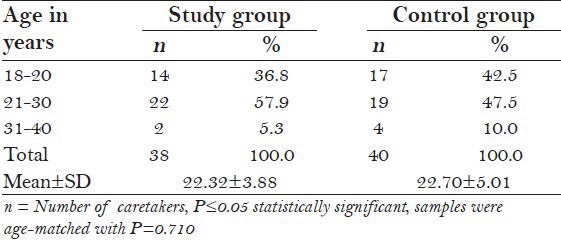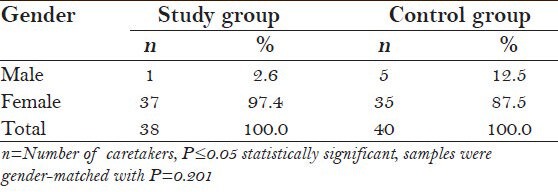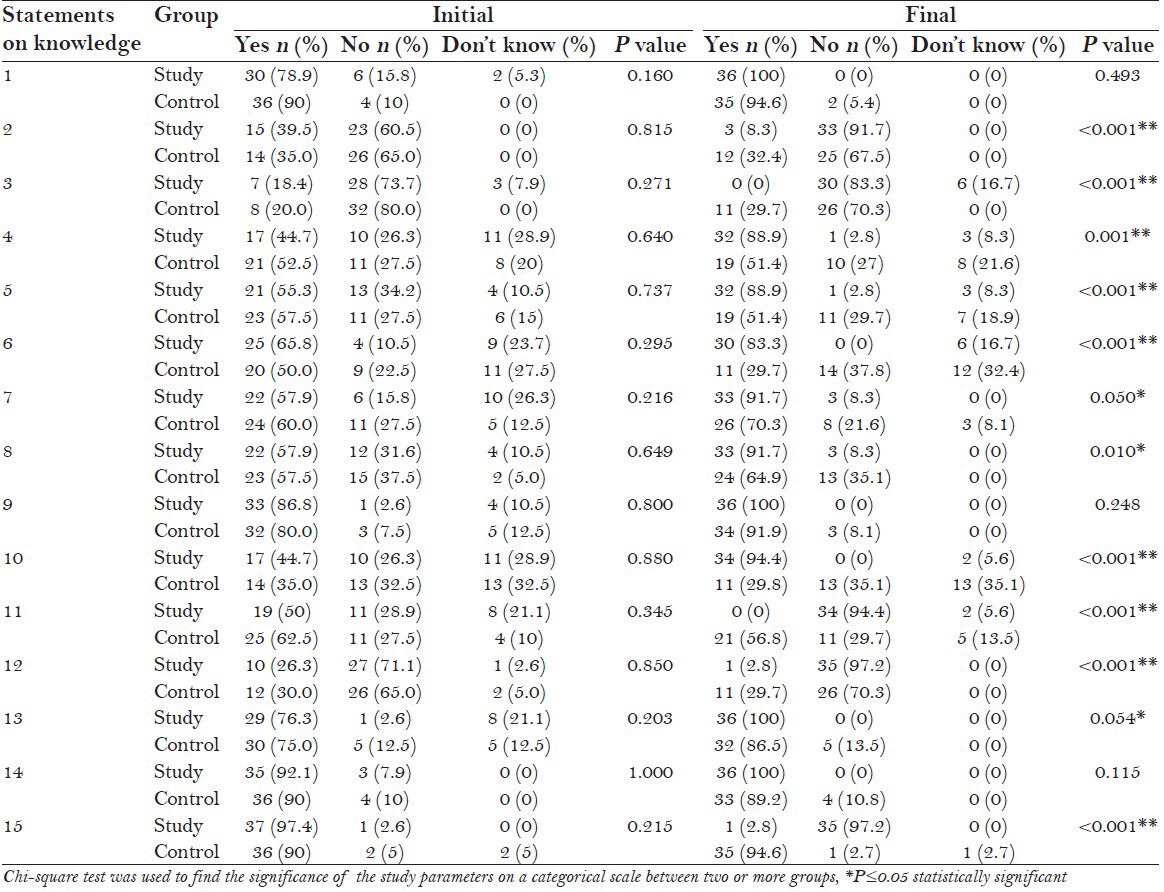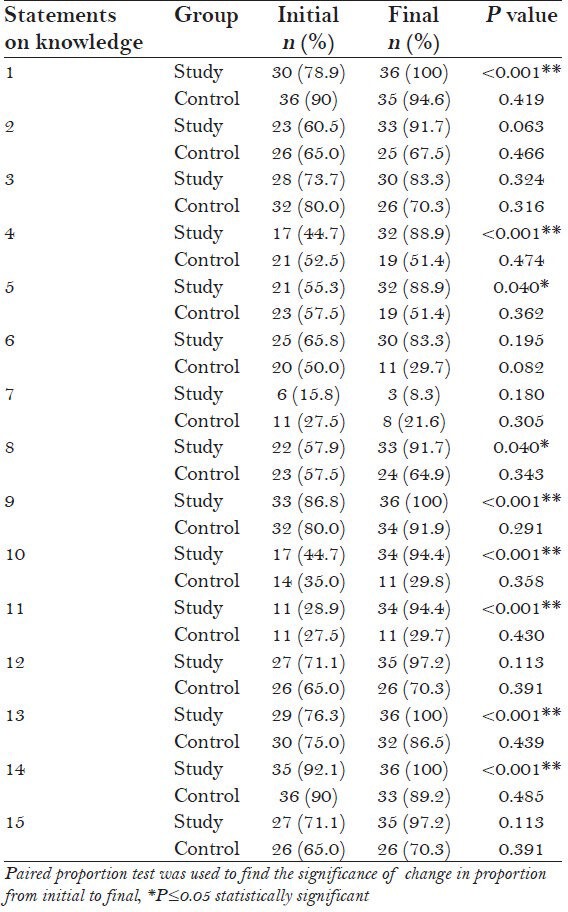Abstract
Background:
The population of older people as well as the number of dependent older people is steadily increasing. Those unable to live independently at home are being cared for in a range of settings. Practical training for nurses and auxiliary care staff has frequently been recommended as a way of improving oral health care for functionally dependent elderly.
Aim:
To evaluate an oral health education program for the caretakers of institutionalized elderly.
Materials and Methods:
The study was a cluster randomized intervention trial with an elderly home as the unit of randomization. Seven out of 65 elderly homes accommodating a total of 78 caretakers and 462 elderly residents were selected in Bangalore city, India, out of which 3 elderly homes were assigned to the intervention group and 4 to the control group. Oral health knowledge of caretakers was assessed using a pre-tested proforma; later, oral health education was provided to the caretakers of the intervention group. Oral health education was given at the end of 6 months to the caretakers of the control group. Chi-square test, Fisher exact test, and paired proportion test were used for statistical analysis.
Results:
There was significant improvement in the oral health knowledge of the caretakers from baseline in the interventional group.
Conclusion:
The results of the present study showed that there was a significant improvement in the oral health knowledge among the caretakers. Educating the caretakers for assisting or enabling residents for maintaining oral hygiene is essential.
Keywords: Caregivers, caretakers, nursing staff, oral health education, oral health promotion
INTRODUCTION
The age distribution of the world's population is changing. With advances in medicine and prolonged life expectancy, the proportion of older people will continue to rise worldwide.
Those unable to live independently at home are being cared for in a range of settings, and varying degrees of dependency means that many are unable to attend fully to their needs.
Those elderly people who live in nursing homes are often frail, have poor manual dexterity, and rely on the knowledge and skills of their caregivers to control and prevent dental disease. Hence, programs promoting oral health for the aged in nursing homes need to focus on educating the caretakers of these people.[1]
Nurses and care staff require the necessary knowledge and skills to effectively meet the oral care needs of older people who are unable to do this for themselves. The need for dental health education of caretakers of elderly people is widely acknowledged and strongly recommended based on the investigations conducted on the dental needs of elderly people.[2,3]
Practical training for nurses and auxiliary care staff has frequently been recommended as a way of improving oral health care for functionally dependent elderly.[4,5] In response to this need, a study was designed to evaluate an oral health education program for the caregivers of institutionalized elderly in Bangalore city, India and to develop the knowledge, attitudes, and behavior that are required for the prevention of dental disease in their clients.
The scientific hypothesis of the present study was that oral health care education for caretakers would result in significant improvement in their oral health knowledge, attitudes, and practices.
MATERIALS AND METHODS
The study was a cluster randomized intervention trial with an institution as the unit of randomization. Research data was gathered at baseline and at 6 months after the start of the study. The study was supervised and monitored by two investigators. The study was conducted according to the principles of the Declaration of Helsinki (version 17c, 2004) and in accordance with the Medical Research Involving Human Subjects Act (WMO). Ethical clearance was obtained from the Institutional Review Board, The Oxford Dental College and Research Centre, Bangalore, India.
Sample size estimation
There were 65 old age homes in Bangalore city, in which there were around 690 caretakers. This information was collected from THE ELDERS HELPLINE 1090 (a project of Bangalore city and Nightingales Medical Trust, a voluntary organization working for elders’ welfare and other sources).
The sample size required for this study was 10% of the caretakers, that is, 70 (35 per group).
A random sample of seven elderly homes accommodating a total of 78 caretakers in Bangalore city was selected. The elderly homes selected had no previous history of Oral Health Education Program. Out of the seven homes, three elderly homes were assigned to the intervention group and four to the control group randomly, which met the required sample of 35 each. Keeping attrition in mind, an additional eight caretakers were taken.
Once the manager of an institution agreed to participate by giving a written informed consent, the institution was randomly allocated to either the intervention group or the control group.
Prior to start of the study, the details of the study were explained to the caretakers and a written informed consent was obtained from the participating caretakers.
A 15-item questionnaire with a three-point Likert Scale (yes, no, and don’t know) was developed in English to assess the oral health information of the caretakers pre and post intervention. Its respective psychometric properties (validity and reliability) were assessed. Content validity was assessed by a panel of eight experts consisting of staff members of the Department of Public Health Dentistry, The Oxford Dental College, Hospital and Research Centre, Bangalore. The purpose was to depict those items with a high degree of agreement among the experts. Aiken's V was used to quantify the concordance between experts for each item; values higher than 0.92 were always obtained.[6]
Before commencing the study, a pilot study was performed among the caretakers in an elderly home to check the internal consistency of the questionnaire. The results thus obtained were subjected to statistical analysis. Cronbach's alpha value of 0.82 showed good internal consistency of the questionnaire.[7]
The questionnaire was distributed among 78 caretakers and the respondents were instructed to fill the questionnaire without discussing with each other; the response rate was 100%. The preliminary section was designed to gather demographic data, and the anonymity of the respondents was assured. The second section was concerned with questions related to oral health knowledge, attitude, and practice.
The health educator was trained before the commencement of the study. He gave a PowerPoint presentation on oral health to the caretakers and a live demonstration of oral hygiene techniques on study models. Also, a health education CD and manual were provided to the respective institutions.
Research data was gathered by another investigator who was not aware of the group allotment, at baseline and at 6 months. At baseline, oral health education and demonstration was provided to the caretakers in the intervention group. Reinforcement of oral health education was given to the caretakers of the intervention group after 3 months, and oral health education was given to the caretakers of the control group at the end of 6 months. Finally, at the end of the study, a process evaluation was conducted in the institutions using the same questionnaire used at the baseline. The investigator did not know whether the institution was allocated to the intervention or the control group.
Statistical analysis
Descriptive statistical analysis was carried out in the present study. Statistical software, namely SPSS 15.0, was used. Chi-square/Fisher exact test was used to find the significance of the study parameters on a categorical scale between two or more groups. Paired proportion test was used to find the significance of change in proportion from initial to final knowledge and practice assessment. Significance was assessed at 5% level of significance with 95% confidence interval.
RESULTS
The present study was carried out for a period of 6 months. Seven elderly homes were randomly selected for the study, of which three were assigned to the intervention group and four to the control group. The intervention group comprised 38 caretakers and the control group comprised 40 caretakers. Two caretakers from the intervention group and three from the control group were lost to follow-up. So, at the post-intervention assessment, there were 36 caretakers in the intervention group and 37 caretakers in the control group.
The oral health information of the caretakers was assessed at baseline (pre-intervention) and after 6 months (post-intervention) by means of a questionnaire.
Table 1 shows the distribution of the caretakers. In the intervention group, there were 38 caretakers at baseline and 36 caretakers after 6 months; in the control group, there were 40 caretakers at baseline and 37 caretakers after 6 months.
Table 1.
Distribution of caretakers

Table 2 shows the distribution of the caretakers according to age. The mean age of the caretakers was 22.32 ± 3.88 years in the intervention group and 22.70 ± 5.01 years in the control group. Comparison of caretakers’ age revealed no statistically significant difference.
Table 2.
Distribution of caretakers according to age

Table 3 shows the distribution of the caretakers according to gender. In the intervention group, 1 (2.6%) caretaker was a male and 37 (97.4%) caretakers were females, whereas in the control group, 5 (12.5%) caretakers were males and 35 (87.5%) were females. Comparison of caretakers’ gender revealed no statistically significant difference.
Table 3.
Distribution of caretakers according to gender

Table 4 shows the comparative evaluation of oral health information of caretakers in the interventional and control groups. At baseline, with respect to the first statement, “Health of mouth is directly related to body,” 30 (78.9%) caretakers from the intervention and 36 (90%) caretakers from the control group answered “yes.” At the end of 6 months, 36 (100%) caretakers from the intervention group and 35 (94.6%) caretakers from the control group answered correctly. There was no statistically significant difference between the groups.
Table 4.
Comparative evaluation of oral health knowledge of caretakers in the study and control groups

With respect to the second statement, “You can chew just as well with denture tooth as with your natural teeth,” 23 (60.5%) caretakers from the intervention group and 26 (65.0%) caretakers from the control group answered “no.” At the end of 6 months, 33 (91.7%) caretakers from the intervention group and 25 (67.5%) caretakers from the control group answered correctly. There was increase in the responses in the intervention group, and the change was statistically significant (P < 0.001).
With respect to the third statement, “When gums bleed during brushing, it is best to leave them alone,” 28 (73.7%) caretakers from the intervention group and 32 (80.0%) caretakers from the control group answered “no.” At the end of 6 months, 30 (83.3%) caretakers from the intervention group and 26 (70.3%) caretakers from the control group answered correctly. There was increase in the responses in the study group, and the change was statistically significant (P < 0.001**).
At baseline, only 17 (44.7%) caretakers from the intervention group and 21 (52.5%) caretakers from the control group answered “yes” to the fourth statement, “Older adults with dry mouth get more cavities.” At the end of 6 months, 32 (88.9%) caretakers from the intervention group and 19 (51.4%) caretakers from the control group answered correctly. There was increase in the responses in the study group, and the change was statistically significant (P < 0.001**).
At baseline, only 21 (55.3%) caretakers from the intervention group and 23 (57.5%) caretakers from the control group answered “yes” to the fifth statement, “The most common cause of dry mouth is medication.” At the end of 6 months, 32 (88.9%) caretakers from the intervention group and 19 (51.4%) caretakers from the control group answered correctly. There was increase in the responses in the study group, and the change was statistically significant (P < 0.001**).
With respect to the sixth statement, “Older adults with teeth need to use fluorides,” 25 (65.8%) caretakers from the intervention group and 20 (50.0%) caretakers from the control group answered “yes.” At the end of 6 months, 30 (83.3%) caretakers from the intervention group and 11 (29.7%) caretakers from the control group answered correctly. There was increase in the responses in the intervention group, and the change was statistically significant (P < 0.001**).
With respect to the seventh statement, “Mouth rinsing is a good alternative to daily tooth brushing,” 6 (15.8%) caretakers from the intervention group and 11 (27.5%) caretakers from the control group answered “no.” At the end of 6 months, 3 (8.3%) caretakers from the intervention group and 8 (21.6%) caretakers from the control group answered correctly. There was decrease in the responses in the study group.
With respect to the eighth statement, “People with no teeth need to be seen by a dentist,” 22 (57.9%) caretakers from the intervention group and 23 (57.5%) caretakers from the control group answered “yes.” At the end of 6 months, 33 (91.7%) caretakers from the intervention group and 24 (64.9%) caretakers from the control group answered correctly. There was increase in the responses in the intervention group, and the change was statistically significant (P < 0.010*).
At baseline, only 33 (86.8%) caretakers from the intervention group and 32 (80.0%) caretakers from the control group answered “yes” to the ninth statement, “Dentures should be removed for few hours every day.” At the end of 6 months, 36 (100%) caretakers from the intervention group and 34 (91.9%) caretakers from the control group answered correctly. There was increase in the responses in both intervention and control groups, and the change was not statistically significant.
At baseline, only 17 (44.7%) caretakers from the intervention group and 15 (37.5%) caretakers from the control group answered “yes” to the 10th statement, “Dentures those don’t fit well can cause oral cancer.” At the end of 6 months, 34 (94.4%) caretakers from the intervention group and 4 (10.8%) caretakers from the control group answered correctly. There was increase in the responses in the intervention group, and the change was statistically significant (P < 0.001**).
At baseline, only 11 (28.9%) caretakers from the intervention group and 11 (27.5%) caretakers from the control group answered “no” to the 11th statement, “It is normal for residents to have pain and sores in their mouth.” At the end of 6 months, 34 (94.4%) caretakers from the intervention group and 11 (29.7%) caretakers from the control group answered correctly. There was increase in the responses in the study group, and the change was statistically significant (P < 0.001**).
With respect to the 12th statement, “Residents who do not cooperate for daily mouth care are best left alone,” 27 (71.1%) caretakers from the intervention group and 26 (65.0%) caretakers from the control group answered “no.” At the end of 6 months, 35 (97.2%) caretakers from the intervention group and 26 (70.3%) caretakers from the control group answered correctly. There was increase in the responses in the study group, and the change was statistically significant (P < 0.001**).
At baseline, only 29 (76.3%) caretakers from the intervention group and 30 (75.0%) caretakers from the control group answered “yes” to the 13th statement, “Dental check-ups are as important as medical.” At the end of 6 months, 36 (100%) caretakers from the intervention group and 32 (86.5%) caretakers from the control group answered correctly. There was increase in the responses in both the groups, and the change was not statistically significant.
At baseline, only 35 (92.1%) caretakers from the study group and 36 (90%) caretakers from the control group answered “yes” to the 14th statement, “Residents can lose their teeth if they remain dirty.” At the end of 6 months, 36 (100%) caretakers from the intervention group and 33 (89.2%) caretakers from the control group answered correctly. There was increase in the responses in the intervention group, and the change was not statistically significant.
With respect to the 15th statement, “As people get old they naturally lose their teeth,” 1 (2.6%) caretaker from the intervention group and 2 (5%) caretakers from the control group answered “no.” At the end of 6 months, 35 (97.2%) caretakers from the intervention group and 1 (2.7%) caretaker from the control group answered correctly. There was increase in the responses in the intervention group, and the change was statistically significant (P < 0.001**).
Intra-group comparative evaluation of oral health knowledge of caretakers is given in Table 5. It reveals that there was significant improvement in the knowledge of caretakers in the intervention group pre and post intervention.
Table 5.
Intra-group comparative evaluation of oral health knowledge of caretakers

DISCUSSION
The population of older people as well as the number of dependent older people is steadily increasing. Those unable to live independently at home are being cared for in a range of settings and with varying degrees of dependency. These dependent elderly people residing at the old age homes are usually bedridden with compromised health conditions. Old age is associated with being edentulous or partially edentulous. Epidemiological studies reveal that in general, the oral health of elderly people is poor.[8] So, oral disease can be considered as a public health problem due to its high prevalence and significant social impact.
Due to the educational level and the professional role of the nurses, it is expected that they have enough knowledge in the community about oral health and its diseases. Keeping in mind the expected role to be played by the nursing staff, a need was felt for assessing the oral health related knowledge, attitude, and practice among these caretakers. A questionnaire written in English was used for the collection of data in this study, which constituted 15 questions. To obtain genuine responses, the anonymity of the respondents was ensured.
Oral health knowledge of caretakers
Oral health promotion seeks to achieve sustainable improvement in oral health and reduce the inequalities through action directed at the underlying determinants of oral health. An essential component of this process is health education. The oral health education program was directed at caretakers, since the functionally dependent elderly residents are unlikely to benefit from direct oral health education. Caretakers were targeted, since they provide personal care for up to 90% of elderly residents. The health education sessions were planned with the achievable aim of increasing the caretakers’ awareness, knowledge, and skills in oral health care. It is well documented that there is significant improvement in the oral hygiene practices of elderly residents by educating their caretakers.[8] In the present study, oral health education intervention was given at baseline and reinforcement was given at the end of 3 months. Oral health education to the control group was provided only at the end of 6 months.
At baseline, the knowledge of caretakers regarding oral health, importance of oral hygiene, denture care and denture hygiene, and importance of dental check-ups was poor. Post intervention, there was significant improvement in the oral hygiene knowledge of the caretakers of the study group, whereas there was no improvement in the oral hygiene knowledge of the caretakers of the control group. There was significant improvement in the knowledge on importance of oral health and oral hygiene, use of fluorides, denture care and denture hygiene practices, management of dry mouth, and importance of regular dental check-ups. These results were similar to those of studies conducted by Paulsson et al.,[8] Simons et al.,[9] and Nicol et al.[10] These improvements reflected the effectiveness of the oral health education program.
However, it is recognized that within long-term care facilities, numerous problems mitigate against routine provision of oral health care and encourage neglect. Some of the reasons for neglect include: Lack of personal perception of oral health problems by residents, inability of residents to articulate a need, family members placing dental care as a low priority, long-term care staff placing patients’ dental care as a low priority, limitations of long-term care staff like heavy workloads and psychological barriers like cleaning other person's mouth, inadequate oral hygiene aids, and difficulty in obtaining dental care.
It is generally more difficult to evaluate the benefits of health education than of direct therapies. The design of this trial and its community setting made it likely to have both internal validity and to be generalizable.
Recommendations
Educating the caretakers for assisting or enabling residents for maintaining oral hygiene is essential; implementation of oral health management in their course curriculum is required; and oral health awareness among these health care providers should be done on a regular basis.
CONCLUSION
The results of the present study showed that oral health knowledge among the caretakers of the elderly residents was poor at baseline; post intervention, there was a significant improvement in the oral health knowledge among the caretakers. So, in the present study, the oral health education provided to the caretakers was effective. Therefore, educating the caretakers for assisting or enabling residents for maintaining oral hygiene is essential.
Footnotes
Source of Support: Nil
Conflict of Interest: None declared.
REFERENCES
- 1.Recommendations for oral health promotion activities with older adults Oral Health Working Group. Gerodontics. 1988;4:207–8. [PubMed] [Google Scholar]
- 2.Hoad-Reddick G, Grant AA, Griffiths CS. Investigation into the cleanliness of dentures in an elderly population. J Prosthet Dent. 1990;64:48–52. doi: 10.1016/0022-3913(90)90152-3. [DOI] [PubMed] [Google Scholar]
- 3.Homan BT, Lam B, Larsen RG. The oral needs and demands of a geriatric population at Mt. Olivet, Brisbane, 1986. Aust Dent J. 1988;33:424–32. doi: 10.1111/j.1834-7819.1988.tb04608.x. [DOI] [PubMed] [Google Scholar]
- 4.Frenkel H, Harvey I, Newcombe RG. Improving oral health in institutionalised elderly people by educating caregivers: A randomised controlled trial. Community Dent Oral Epidemiol. 2001;29:289–97. doi: 10.1034/j.1600-0528.2001.290408.x. [DOI] [PubMed] [Google Scholar]
- 5.Schou L, Wight C, Clemson N, Douglas S, Clark C. Oral health promotion for institutionalised elderly. Community Dent Oral Epidemiol. 1989;17:2–6. doi: 10.1111/j.1600-0528.1989.tb01815.x. [DOI] [PubMed] [Google Scholar]
- 6.Hernández R, Fernández C, Baptista L, editors. 2nd ed. Mexico DF: McGraw Hill; 1999. Methodology the Research (Research Methodology) pp. 112–4. [Google Scholar]
- 7.Muñiz J, editor. 2nd ed. Madrid: Ediciones Pyramid; 2000. Classical Theory of Tests (Tests Classic Theory) pp. 88–90. [Google Scholar]
- 8.Paulsson G, Fridlund B, Holmén A, Nederfors T. Evaluation of an oral health education program for nursing personnel in special housing facilities for the elderly. Spec Care Dentist. 1998;18:234–42. doi: 10.1111/j.1754-4505.1998.tb01640.x. [DOI] [PubMed] [Google Scholar]
- 9.Simons D, Baker P, Jones B, Kidd EA, Beighton D. An evaluation of an oral health training programme for carers of the elderly in residential homes. Br Dent J. 2000;188:206–10. doi: 10.1038/sj.bdj.4800432. [DOI] [PubMed] [Google Scholar]
- 10.Nicol R, Petrina Sweeney M, McHugh S, Bagg J. Effectiveness of health care worker training on the oral health of elderly residents of nursing homes. Community Dent Oral Epidemiol. 2005;33:115–24. doi: 10.1111/j.1600-0528.2004.00212.x. [DOI] [PubMed] [Google Scholar]


